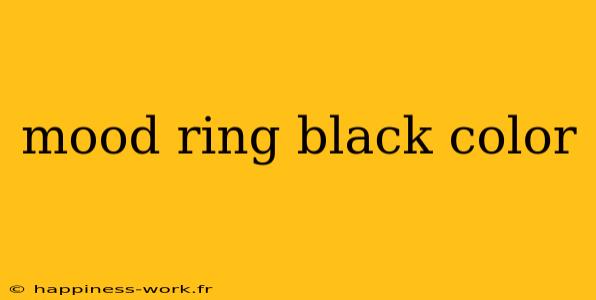Mood rings have fascinated people since their inception in the 1970s, believed to reflect your emotional state based on the temperature of your fingers. While the wide array of colors associated with these rings can offer insights into your mood, the black color in particular raises some intriguing questions. This article explores the significance of the mood ring black color, its implications for your emotional state, and practical tips for using mood rings in your life.
What Does the Black Color Indicate?
According to WikiHow, a black mood ring typically indicates stress, anxiety, or even a sense of feeling overwhelmed. When a mood ring turns black, it suggests that the wearer is experiencing negative emotions or turmoil.
Analysis of Mood and Color
The interpretation of color in mood rings has psychological and physiological underpinnings. When you're stressed or anxious, your body temperature can drop, which may cause the liquid crystal inside the mood ring to change color to black.
Example: Imagine someone facing a heavy workload or personal crisis. The stress from these responsibilities may lower their body temperature, triggering the mood ring to reflect that emotional state by turning black.
Is Black Always Bad?
While seeing a black hue on your mood ring can be disheartening, it’s essential to recognize that this color is not inherently negative. Black may also indicate introspection and the need for solitude.
Acknowledging the Nuance
It's crucial to approach mood ring readings with a nuanced perspective. For instance, a person who values alone time may find themselves in a period of introspection, leading to a black reading that doesn't necessarily correlate with distress.
Practical Example: If someone takes a break from socializing and enjoys some quiet time, their mood ring may indicate black, representing a positive decision to recharge rather than a sign of overwhelming stress.
How to Manage Black Mood Ring Indicators
1. Reflect on Your Feelings
Understanding why your mood ring shows black is the first step toward addressing your emotions. Reflect on what might be causing stress or anxiety in your life. Journaling can help clarify your feelings.
2. Practice Relaxation Techniques
Engaging in mindfulness activities, like meditation or deep breathing exercises, can help alleviate stress and bring your emotional state back into a more balanced spectrum, potentially changing the ring's color.
3. Talk About It
Sometimes, verbalizing your feelings with a trusted friend or therapist can lift a weight off your shoulders. This act of sharing can serve as an emotional release, helping you manage the underlying causes of your anxiety or stress.
Conclusion: Embracing the Mood Ring Experience
Mood rings, while not scientifically rigorous, offer a fun and reflective way to explore our emotional states. The black color serves as a reminder to pay attention to our feelings and take steps to manage stress. Instead of viewing the color as a purely negative signal, consider it an opportunity for introspection and emotional growth.
Remember:
- The meaning of the black color can vary; it doesn’t always equate to distress.
- Use mood rings as a starting point for deeper emotional exploration rather than a definitive indicator of mental health.
By understanding the implications of the mood ring black color, we can foster greater emotional awareness and develop healthier coping mechanisms.
For more detailed insights into the colors of mood rings, check out the full guide on WikiHow by its original authors.
